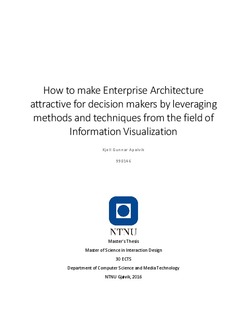| dc.contributor.advisor | Kallergi, Amalia | |
| dc.contributor.advisor | Helkala, Kirsi | |
| dc.contributor.author | Apalvik, Kjell Gunnar | |
| dc.date.accessioned | 2016-09-14T12:54:31Z | |
| dc.date.available | 2016-09-14T12:54:31Z | |
| dc.date.issued | 2016-09-14 | |
| dc.identifier.uri | http://hdl.handle.net/11250/2407250 | |
| dc.description.abstract | Enterprise Architecture is a relatively young architectural discipline that merges strategic business goals and information technology objectives. It is considered to be a promising instrument to provide management with insight and overview to drive portfolio planning in a holistic context. Despite its promises, architects discern a reluctance by decision-makers to include and use architectural products in their business processes. This master thesis examined underlying causes for that lack of interest by performing a case study in the Norwegian Defense. Interviews, augmented by observation and document inspection were used to collect data. The data analysis revealed lack of understanding to be a principal issue. Innate complexity and alienation caused by unfamiliar terms were pointed out as essential sources. Additionally, this master thesis studied how Information Visualization potentially could increase the attractiveness of architectural products. A thorough literature review was conducted to discover techniques on how to represent complex information, and to identify best practices on how to present such information in novel and inspiring ways. Findings indicate that a conscious application of methods and techniques from Information Visualization can have a positive impact on presentation of complex architectural information. Guiding principles are pointed out to be clarification, customization and standardization. However, this will require some adjustments in the architects’ skillset. Among others, basic knowledge to decide on appropriate encoding and how to do storytelling with visualization. Further research could be used to verify these indications, by comparing attractiveness of architectural products before and after an implementation of methods and techniques put forward in this study. | nb_NO |
| dc.description.abstract | Enterprise Architecture1 er en forholdsvis ung arkitektonisk disiplin. Den brukes til å beskrive sammenhengen i en virksomhet, fra strategiske forretningsmål til planlegging og bruk av informasjonsteknologi for å oppnå disse. Det anses for å være et lovende instrument for å gi ledelsen innsikt til å kjøre helhetlig porteføljestyring. Til tross for denne muligheten, oppfatter arkitektene en motvilje blant beslutningstakere til å inkludere og bruke arkitekturprodukter i sine beslutningsprosesser. Denne masteroppgaven undersøker bakenforliggende årsaker til denne manglende interesse ved å utføre en casestudie i Forsvaret. Datainnsamlingen foregikk hovedsakelig med hjelp av intervjuer, men observasjon og dokumentinspeksjon ble også brukt for å kompletter bildet. Analysen av dataene viste først at mangel på forståelse var hovedproblemet. Iboende kompleksitet og fremmedgjøring forårsaket av ukjente begreper ble pekt ut som viktige årsaker. I tillegg ble det undersøkt hvordan visualisering kan bli brukt for å gjøre det mer fristende å bruke arkitektur. En litteraturstudie ble avholdt for å oppdage representasjonsteknikker for kompleks informasjon, og for å identifisere nye og inspirerende måter å presentere denne på. Funnene tyder på at en bevist bruk av metoder og teknikker, som forenkling, tilpasning og standardisering kan ha en positiv innvirkning på presentasjonen av komplekse arkitekturprodukter. Det vil imidlertid kreve at arkitektene tilegner seg grunnleggende kunnskap om informasjonsvisualisering. Hvorvidt de funnene og de beskrevne forslagene til forbedring virker i praksis kan være interessant å forske videre på. | nb_NO |
| dc.language.iso | eng | nb_NO |
| dc.subject | Information Visualization | nb_NO |
| dc.subject | Enterprise Architecture | nb_NO |
| dc.subject | Enterprise | nb_NO |
| dc.subject | Network operations | nb_NO |
| dc.subject | INI | nb_NO |
| dc.title | How to make Enterprise Architecture attractive for decision makers by leveraging methods and techniques from the field of Information Visualization | nb_NO |
| dc.type | Master thesis | nb_NO |
| dc.subject.nsi | VDP::Technology: 500::Industrial and product design: 640 | nb_NO |
| dc.source.pagenumber | 123 | nb_NO |
